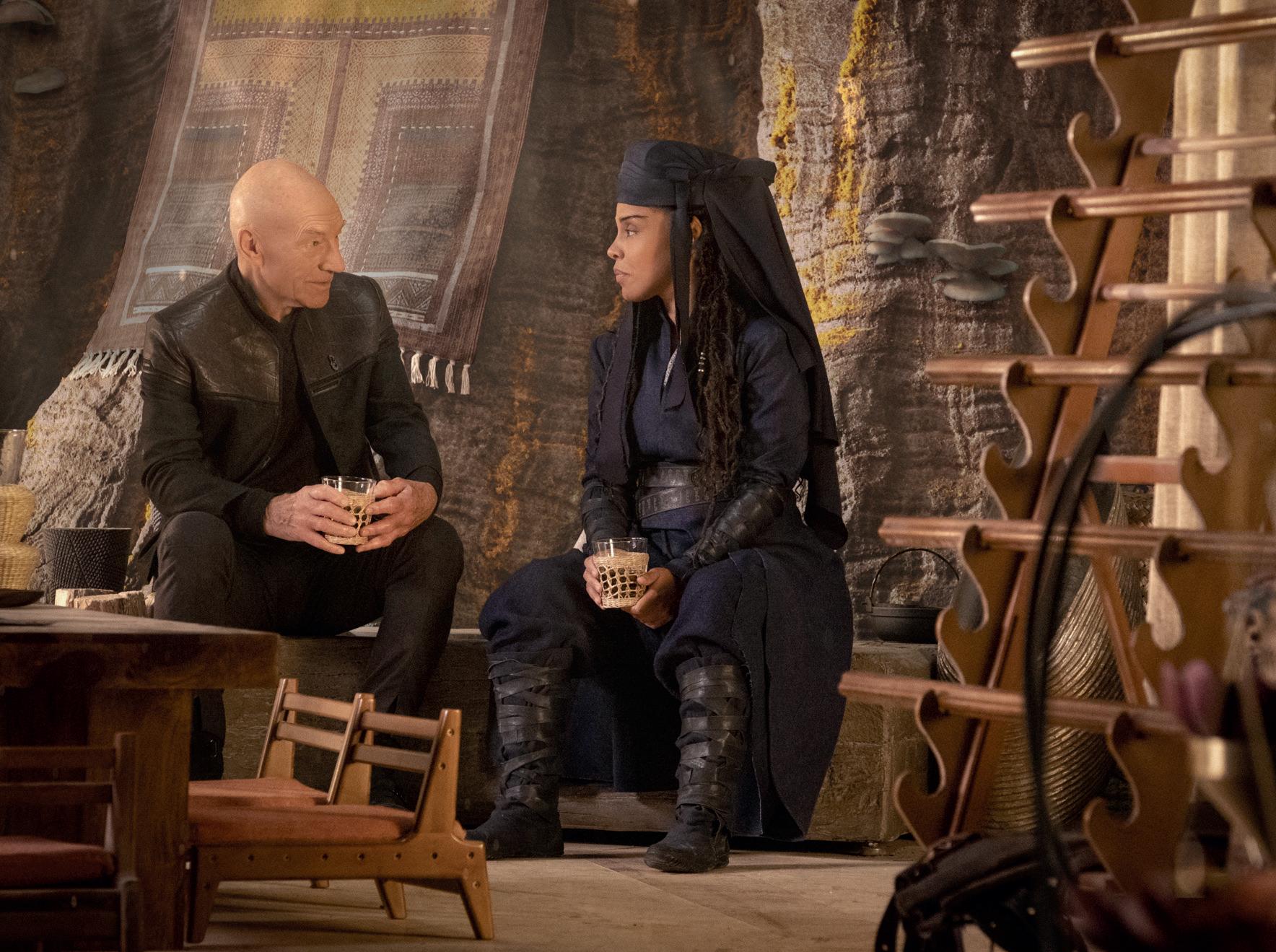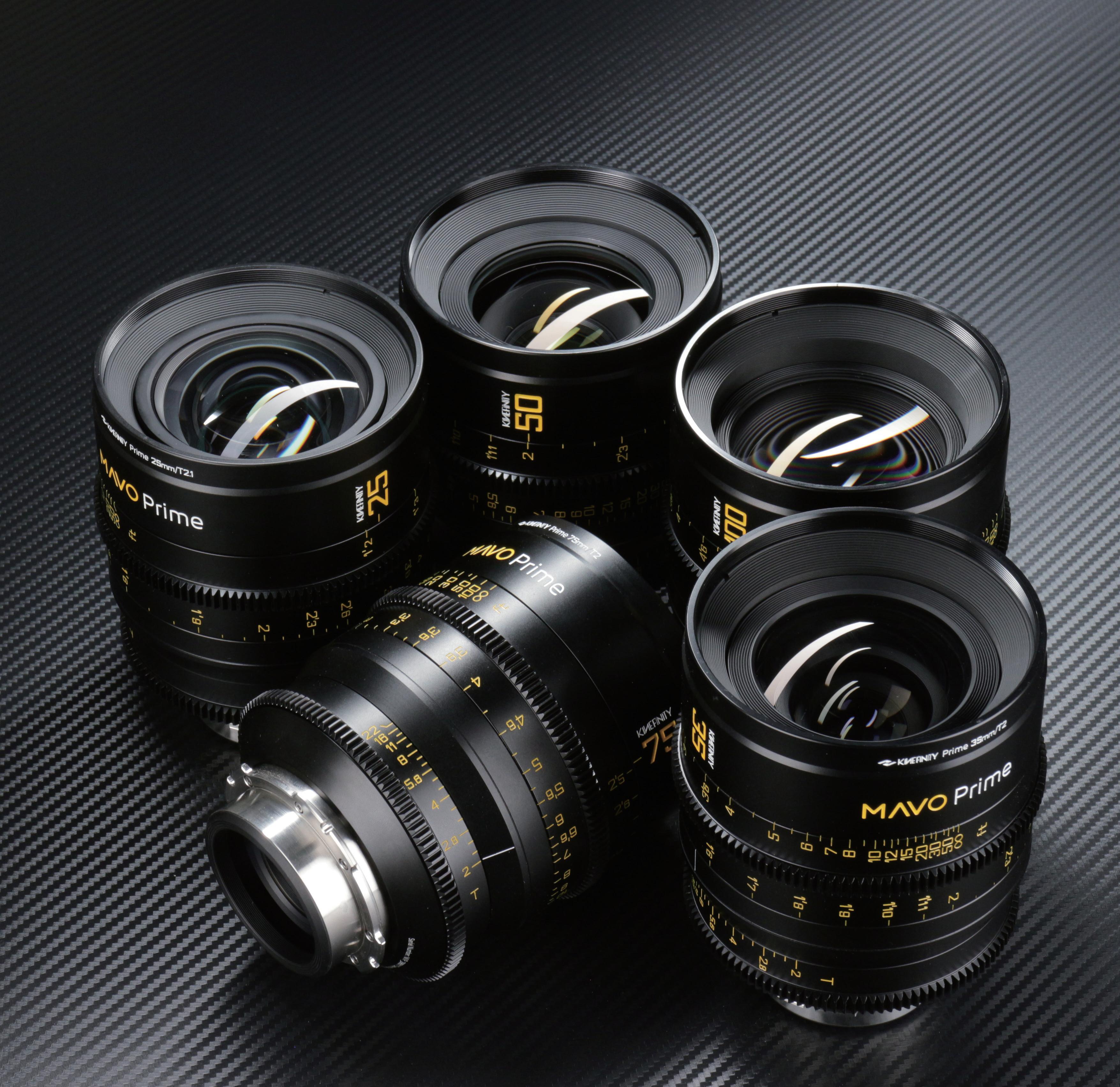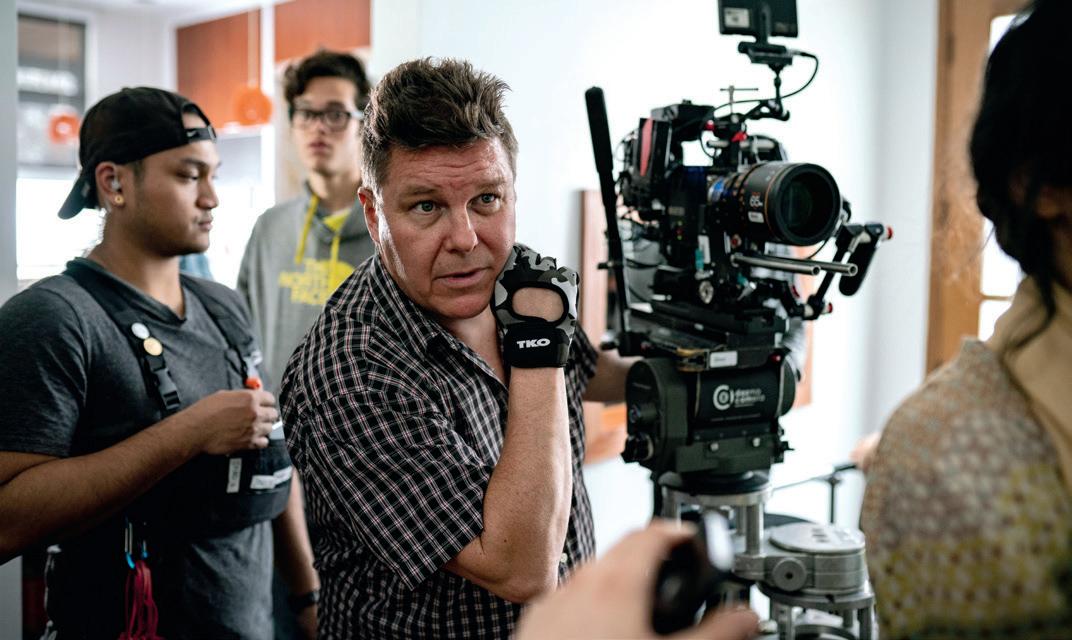
30 minute read
On Set
him how he wanted me to shoot it, and he said, “I like your emotional sense. Just follow your feelings.” His confidence was a great responsibility. I watched the rehearsals of the dance, I felt it and I shot it. He was very happy with the result. This was an amazing boost for my confidence in my early career days. And it taught me a great lesson – when it comes to art, emotion is just as important as technique, sometimes even more important.
What do you like best about what you do?
The ability to create something, to turn your imagination, vision, point of view into reality, to make people feel something, react to and interact with what they’re watching and the story you’re telling. And I like that my job is non-routine. There’s always something new, whether it’s ideas, techniques, locations, or even people.
What do you like least about what you do?
Spending time away from my daughter and having to wake up really early sometimes.
What do you think has been the greatest invention (related to your craft)?
Pretty much all the advances in technology since going digital. Cameras now offer much stronger specs. You can even film an entire movie on your phone and screen it theatrically. The options are endless, and we now have effective solutions for many problems we used to face in the past. Things are more flexible and easier now, which enables anyone to work, create and translate their vision with whatever possibilities are available to them. This means the scene is richer and the competition is higher, which is always in the interest of the industry.
How can others follow your work?
My website: ahmadalmorsy.com Vimeo channel: vimeo.com/ahmadalmorsy FB: facebook.com/ahmadalmorsycsc IG: instagram.com/ahmadalmorsy
Credit: Miz Monday
Credit: Connor Vu


Credit: Jazmina Alzaiat Cinematographer and associate member Michael Jari Davidson considers the anamorphic frame in a pivotal scene from Reem Morsi’s near-future, dystopian thriller HYSTERIA.
Cinematographer Quan Luong (student member), 1st AC Ryan Offenloch (student member), gaffer Markus Henkel, production designer Jordan Moreau on the set of Mansanas (dir. Erin Hembrador).
1st AC Cameron Gonzales watches on as DP Liam Higgins (associate member) frames up the shot of actor Giacomo Giannotti with director Justin Wu on set for Nobis Apparel.
Credit: Parker Tolifson

Director Greg Olliver (L) and DP Matt Irwin (associate member) discuss a setup while shooting an NCAA commercial for Invesco in San Francisco.
CORRECTION: Two photos in the May issue "On Set" page were incorrectly captioned. The caption for the photo on the bottom left on page 10 should read: C camera operator J.P. Locherer csc (right) on the set of Star Trek: Discovery Season 3. Credit: Andrew Stretch. The caption for the photo on the bottom right should read: Associate Member Liam Higgins on set for Nobis Apparel for their SS2020 campaign. Credit: Jazmina Alzaiat
Pierre Gill csc Shedding Light on
TRANSPLANT

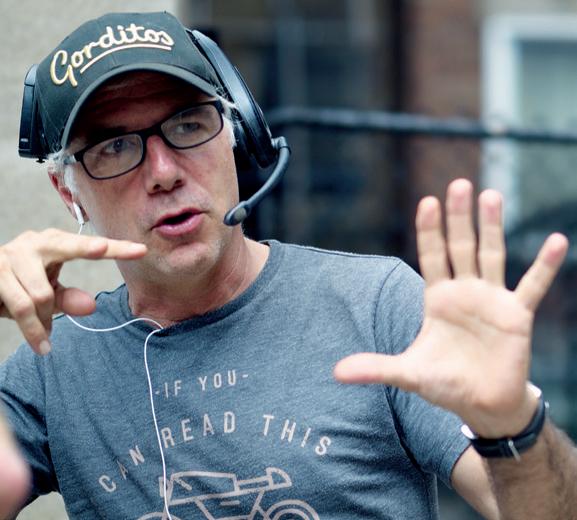
TRANSPLANT
By Trevor Hogg, Special to Canadian Cinematographer
The title for the medical drama Transplant, airing on CTV and produced by Sphere Media, refers to both the personal and professional circumstances of the protagonist who is a refugee and a doctor. The series revolves around Dr. Bashir “Bash” Hamed (Hamza Haq), fleeing with his younger sister Amira (Sirena Gulamgaus) from Syria to Canada where he earns a residen cy at the Emergency Department at York Memorial. The first season of 13 episodes was conceived by creator Joseph Kay (This Life) and photographed by Pierre Gill csc, who collaborated with director Holly Dale (Mary Kills
People) on the pilot, as well as directors Erik Canuel (Bon Cop Bad Cop), Alain Desrochers (Bad Blood) and Stefan Pleszczynski (Killjoys) on the re maining episodes. The series was recently picked up for a U.S. run by NBC.
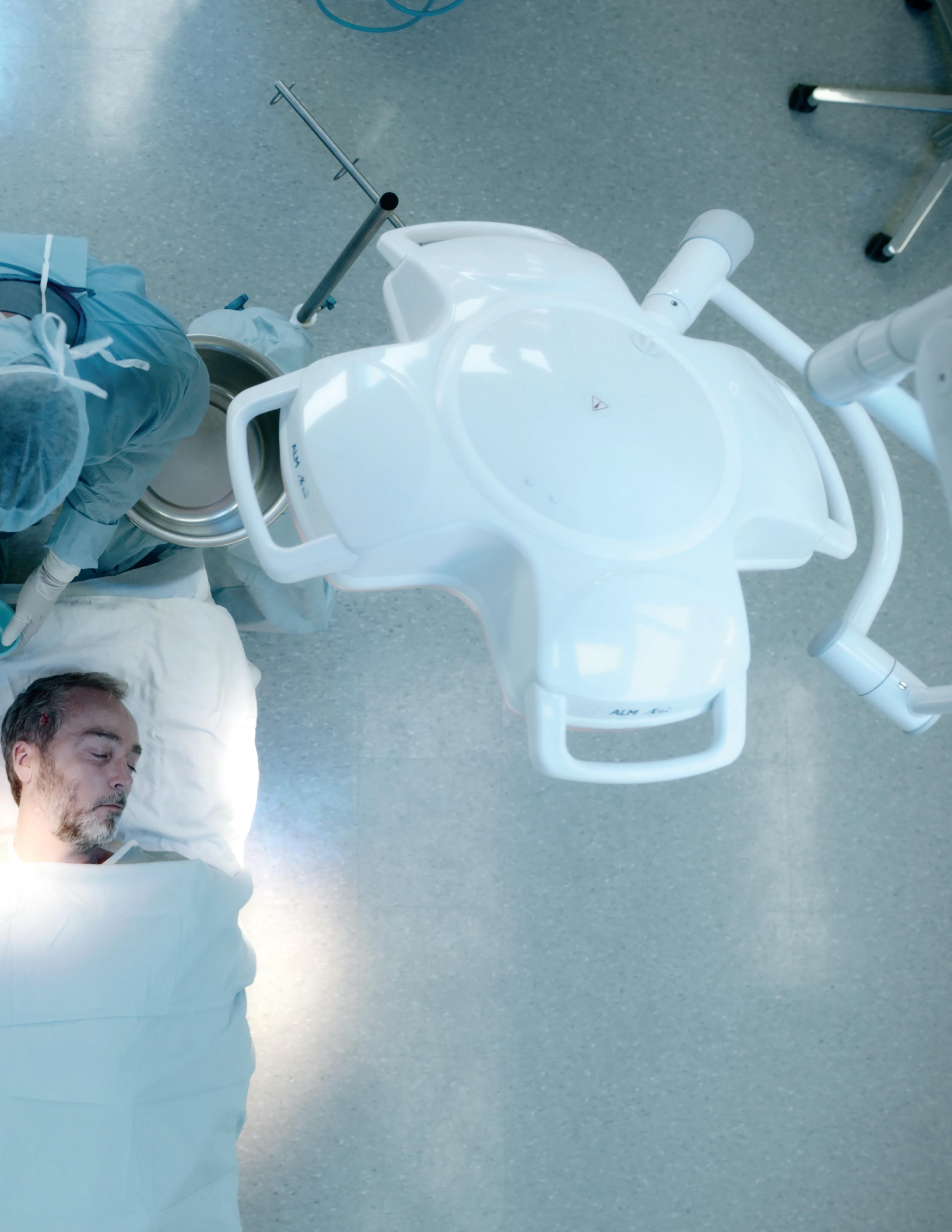
Inset Credit: Yan Turcotte
Hamza Haq and John Hannah in the pilot episode.
Gill and Dale shared the same vision for Transplant, wanting to capture darker wall colours to prioritize faces. “But that was tricky, as you can’t go too dark because it’s a hospital,” Gill notes. “It’s not a story about a doctor who is doing weird experiments on patients, so you can’t light and shoot in a hip cool way because it does not work. As a creative, it’s harder, but the priority is to make the right decision for the show. A DP on a series is the gatekeeper who makes sure that the look remains consistent.” He and production designer André Guimond spent preproduction conceiving a style for the show, and Gill made his camera and lens selection, opting for the Sony VENICE with Sigma primes in Large Format, two Steadicams and two dollies. Rather than shoot on location, the production decided to build a 30,000-square-foot hospital set at Grandé Studios in Montreal. “We broke the wall between two sound stages to create one big one,” Gill explains. “It was 200 feet long. You would go in and think that you’re inside a hospital with a full ceiling. I alsowanted to make sure that we could shoot 360 degrees everywhere because I knew that in a hospital show, doctors always come out of a room talking to each other while walking down a few corridors. My interest was to build a lighting pattern that I could modulate to shoot freely, especially because we see very far since the set is built with glass doors and windows everywhere. So in order to recreate the fluorescent ceiling lighting of a hospital, I got SoftBox Integration to build hundreds of DMX-controlled LED fluorescent-style fixtures, and Cyrille Chatelain to install 1,000 feet of LED lines, all to be put on a board. My extensivelighting plan reflected the square footage and was skilfully put in place by my amazing gaffer René Guillard. “At the beginning, the producer asked, ‘You’re going to put
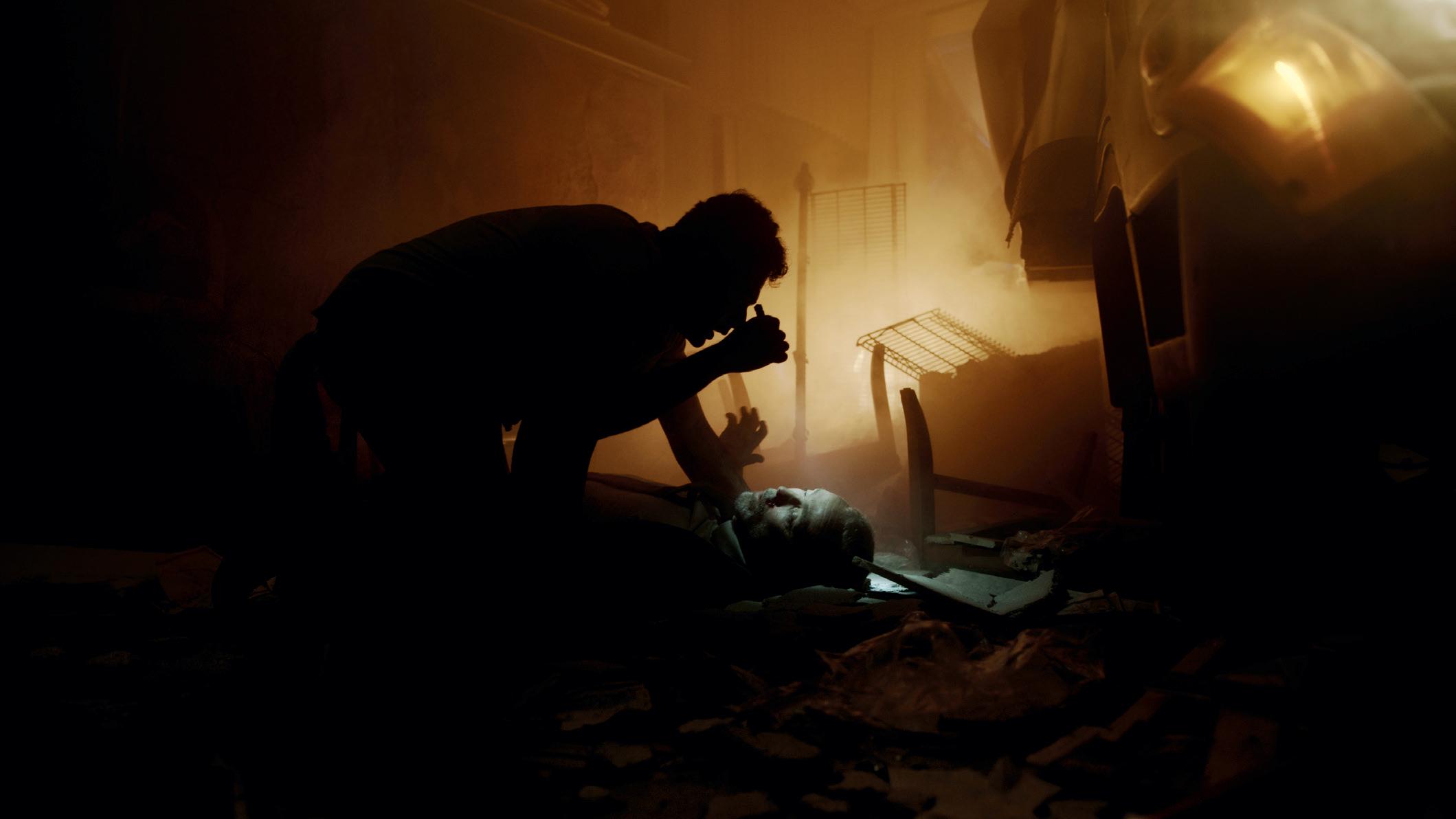
standard fluorescents everywhere?’ And I said, ‘You don’t want to do this because you cannot control them. You’ll have guys on stepladders turning them on or turning them off with breakers. It’s time-consuming and you end up compromising the quality due to shooting schedules,’” Gill says. “That’s why my plan was to build a setup where all of the fixtures are LEDs controlled by DMX and plugged into a console board. Even if the cost of the setup was higher, the crew was much smaller and very efficient. So in the end, it’s cheaper, especially with multiple seasons in mind. Every fixture has a cost, and I had to figure out how to stay within my budget, which was the hardest part, especially to accommodate changes in the set design at the last minute. I always tell students in my master classes that if you want to be a DP, then you better be a good businessman, as you have to be taking care of many more things than just being an artist.” Originally, the plan was to use a lighting board operator on set with a GrandMA, but Gill quickly reconsidered. He explains: “I thought I’m going to say to my gaffer, ‘Light numbers M3, M5, M7, put them in daylight,’ and my gaffer is going to say to the board operator, ‘Put light numbers M3, M5, M7 in daylight.’ I’d say, ‘Brighter,’ and he’d repeat, ‘Brighter.’ I thought, ‘I’m going to be spending an hour just trying to explain what I want in every
Laurence Leboeuf as Dr. Magalie “Mags” Leblanc and John Hannah.
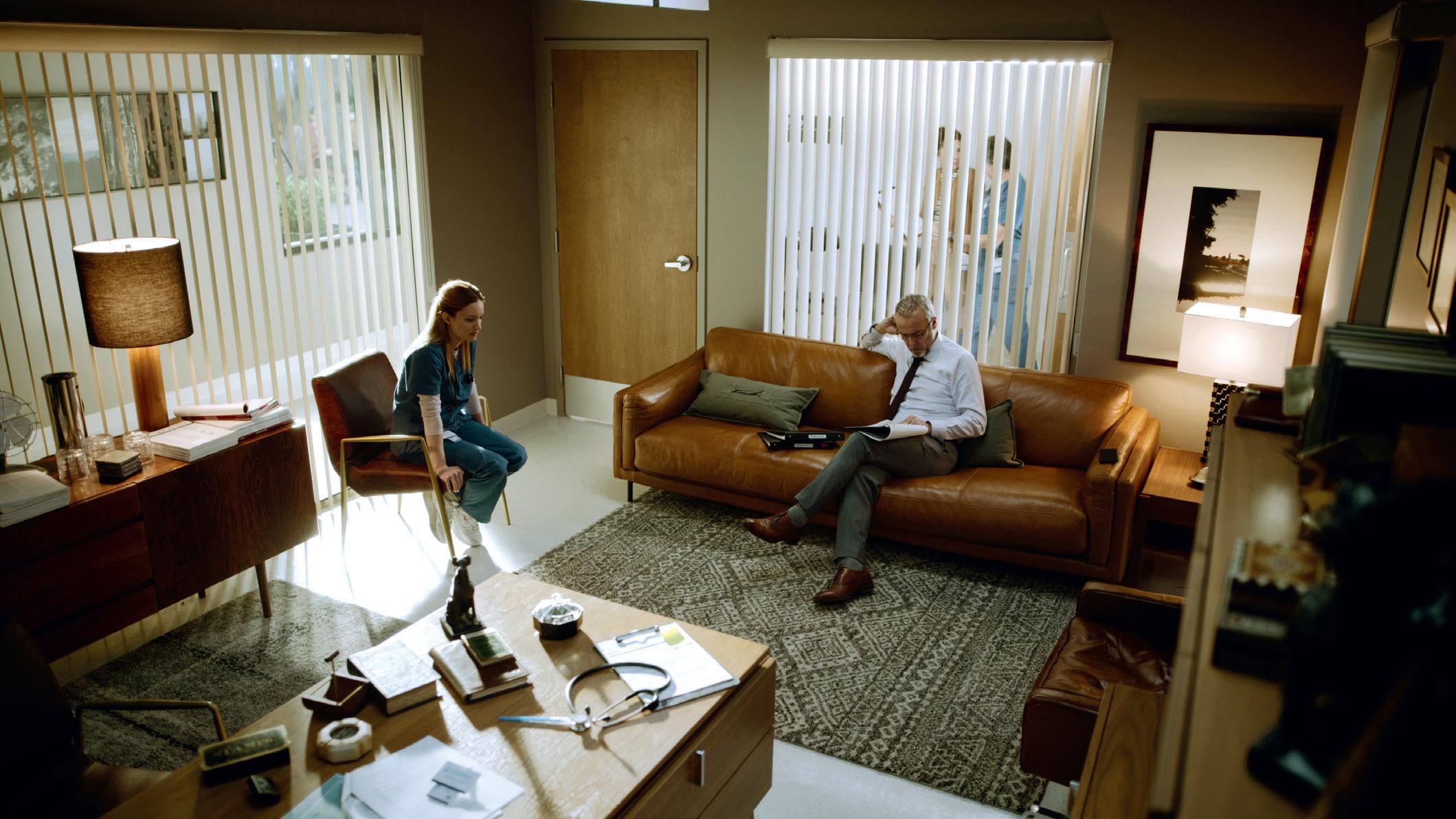
scene. It’s going to be long and exhausting!’ There are between 50 and 250 lights to adjust on every setup. That’s when my board operator suggested that you can use an ETC console and do it yourself. The console is analogue so there’s no computing. We decided to switch, and that was a good call.” Another consideration for Gill was how to deal with all the glass that was in the large set, which made it possible to see everywhere in the space. “So even if you’re in a small room, you could see maybe 50 to 60 feet away or more,” he explains. “With my console setup, I was able to light up the far background quite bright, midground lower, and then modulate the room depending on which angle that we shot.” Out of a total of 582 lighting fixtures, 400 speciality LEDs could be turned off, turned up, dimmed, made colder or warmer. “For budget purposes, I had a section at the far end where I installed light panels bought at Home Depot,” Gill says. “I could control them a little bit with a dimmer but not the colour. All the practical lightbulbs or fluorescents hanging over the counters was the art department trying to find something that works for me but looks good on set. “Since I wanted to be free to shoot 360 on set, my approach was to do a contrast ratio that would work for all of the faces with very
John Hannah and Torri Higginson as Claire Malone.
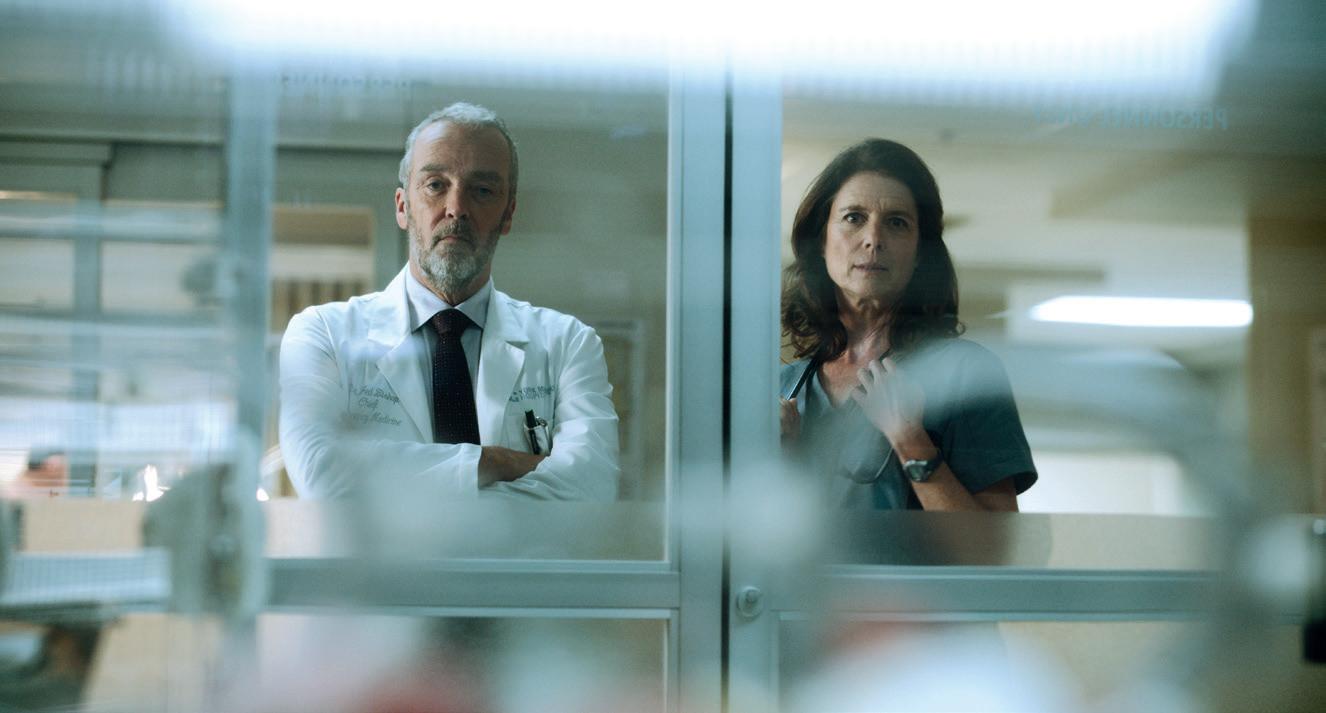

All photos this spread courtesy of Bell Media and Sphère Média.

Camera trainee Quentin Locht.







Pierre Gill csc (centre) with dolly grip Joshua Jones (left) and A camera operator Jean-Sébastien Caron (right).
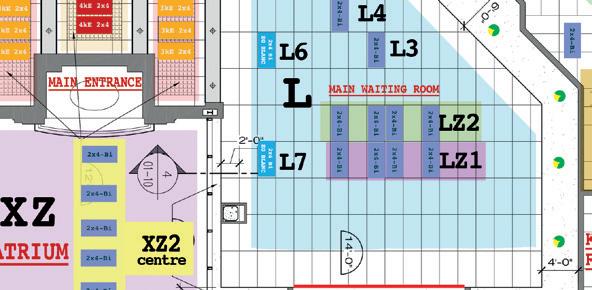
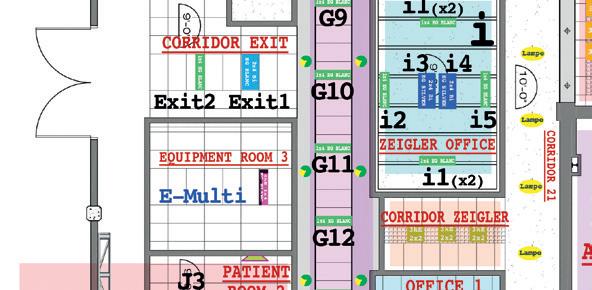

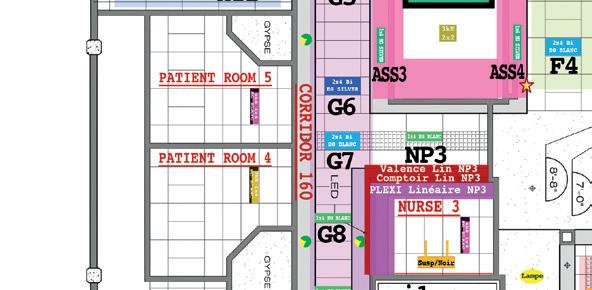


Hamza Haq and Laurence Leboeuf on set.


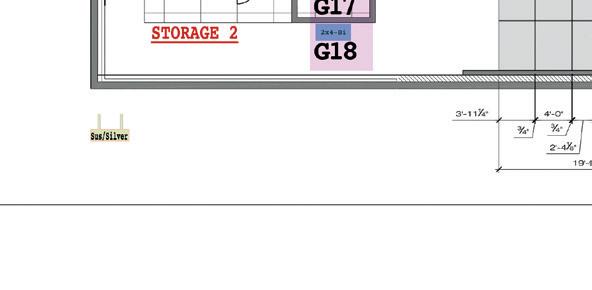

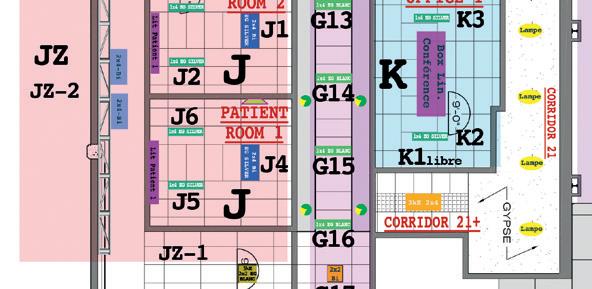
Transplant hospital set lighting diagram provided by Pierre Gill csc.

Top: Hamza Haq in the pilot episode. Bottom: Operating room on the set of Transplant.

diff erent skin tones,” he continues. “My LUT was built and based on our main actor Hamza Haq’s skin, so wall colours, wardrobe, hair and makeup were adjusted on other actors to blend in properly with the colour of his face. Most of the time, I barely added any lights on the fl oor. Sometimes I was putt ing some diff usion over the actors on the LED fi xtures. My grip, Benoît Lamarche, came up with a system with magnets that was very quick. He got on a stepladder, put four magnets, put the diff usion, and it was done. It took one minute. My control room was situated in the elevator cage in the middle of the set. We called it my ‘Bat Cave.’ Aft er the blocking, I would set up shots with the director and my camera operators, go back to my Bat Cave and talk to the operators with my headset system and say, ‘Pan right a bit.’ I would then adjust the background sometimes in a matt er of seconds.” Because the lighting setup could be changed quickly, Gill adds, “I was telling the directors who came in, ‘If you change your mind about where you want to shoot in the set, just change it because I can be ready anywhere in fi ve minutes.’” For example, in one sequence shot in a corridor, Gill was able to go from a night to a day look “in literally two minutes,” he says. “I looked at the background and thought, ‘Let’s have it colder, brighter, turn off these,’ and I just did it live with my fi nger like a DJ. “It took four ETC consoles, each with 144 channels, that were colour coded green, pink, orange and yellow. I spent the fi rst days of shooting very stressed because I didn’t know if it was going to work or crash, and I didn’t have a board operator with me anymore,” he admits. “I had two monitors in front of me so I could see the camera images. I did it by eye, no more talking, no more numbers. It was really cool because you’re lighting as you go. I was ready most of the time before the camera and crew or set decoration. Every day I was going into my Bat Cave and saying to myself, ‘Th is is just unbelievable.’ Th e set was perfect. If we had built a studio and had diff erent sets like a kitchen, house and a living room, it would have been diff erent. I’m not sure it would have worked for that because you don’t have a ceiling with fl uorescents. On this one, I was like, ‘We need to do it because it’s a hospital and I need to modulate it to create a nicer look.’ To be honest, it was a DP’s dream and an accomplishment.”
The search is over

At Vistek, you’ll discover a selection of lights and lighting accessories you simply won’t fi nd anywhere else: recognized brands you know and trust in a range of models suited to every application. Whether you’re working in studio, on set or online, we’ve got a dazzling array of options – from simple oncamera LED lights to elaborate production solutions – to choose from. Come to Vistek.
And see the light.
LIGHTING BRANDS AVAILABLE INSTORE AND ONLINE AT VISTEK.CA
CREATIVE FRONTIER PHILIP LANYON csc STAR TREK PICARD
Credit: Matt Kennedy/CBS ©2019 CBS Interactive, Inc. All Rights Reserved. BY TREVOR HOGG, SPECIAL TO CANADIAN CINEMATOGRAPHER A fter a 17-year absence from the Star Trek franchise, Patrick Stewart gets his own series with Star Trek: Picard, which has been renewed for a second season on CBS All Access. The story revolves around a retired and disillusioned Captain Jean-Luc Picard being approached by a mysterious girl seeking his protection from a secret Romulan organization that is hunting her. Sharing cinematography duties on the initial 10 episodes were Philip Lanyon csc ( Frontier ) – who was responsible for six episodes including the pilot – and Darran Tiernan isc ( Westworld ), with second unit support provided by Chris Mably csc ( Baroness Von Sketch Show ). “The writing and producing teams were so supportive and collaborative with the cinematography; they really let me have fun and explore ideas.”
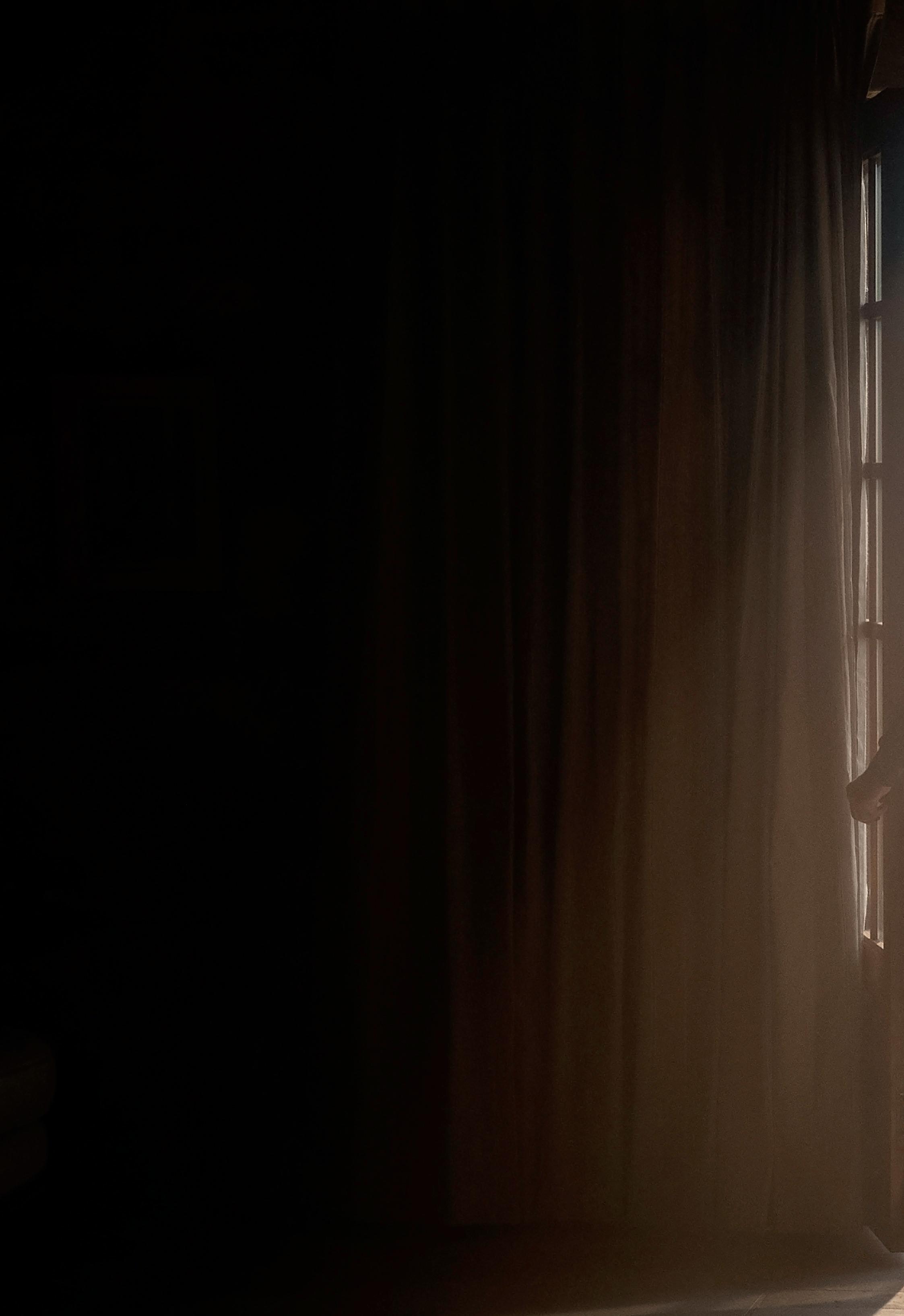
Mian photo: Patrick Stewart as Jean-Luc Picard in Episode #101, “Remembrance” of the the CBS All Access series Star Trek: Picard .
Santiago Cabrera as Rios; Michelle Hurd as Raffi in Episode #106, "The Impossible Box" .
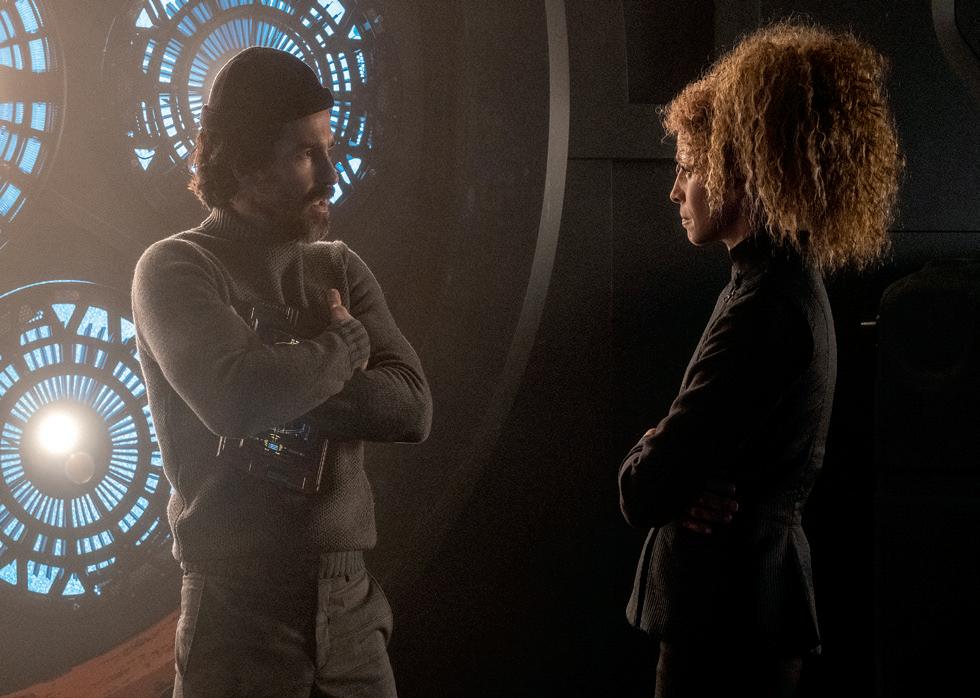
Harry Treadaway as Narek.


Orla Brady as Laris; Jamie McShane as Zhaban; Sir Patrick Stewart as Jean-Luc Picard in Episode #102 "Maps and Legends".
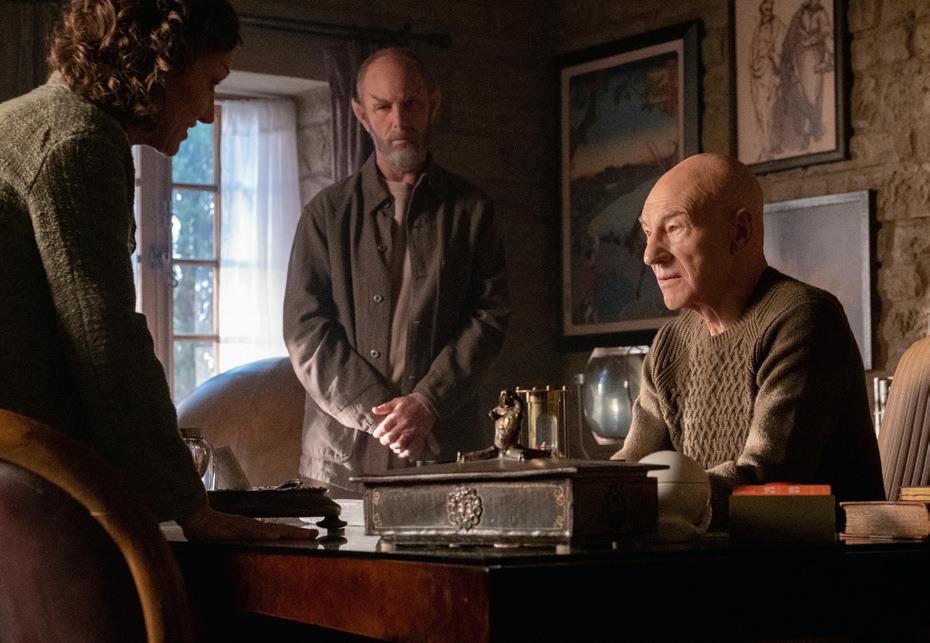
Behind-the-scenes of director of photography Philip Lanyon csc in Episode #101 "Remembrance"

(L-R) Evan Evagora as Elnor; Sir Patrick Stewart as Picard in Episode #106 "The Impossible Box”.
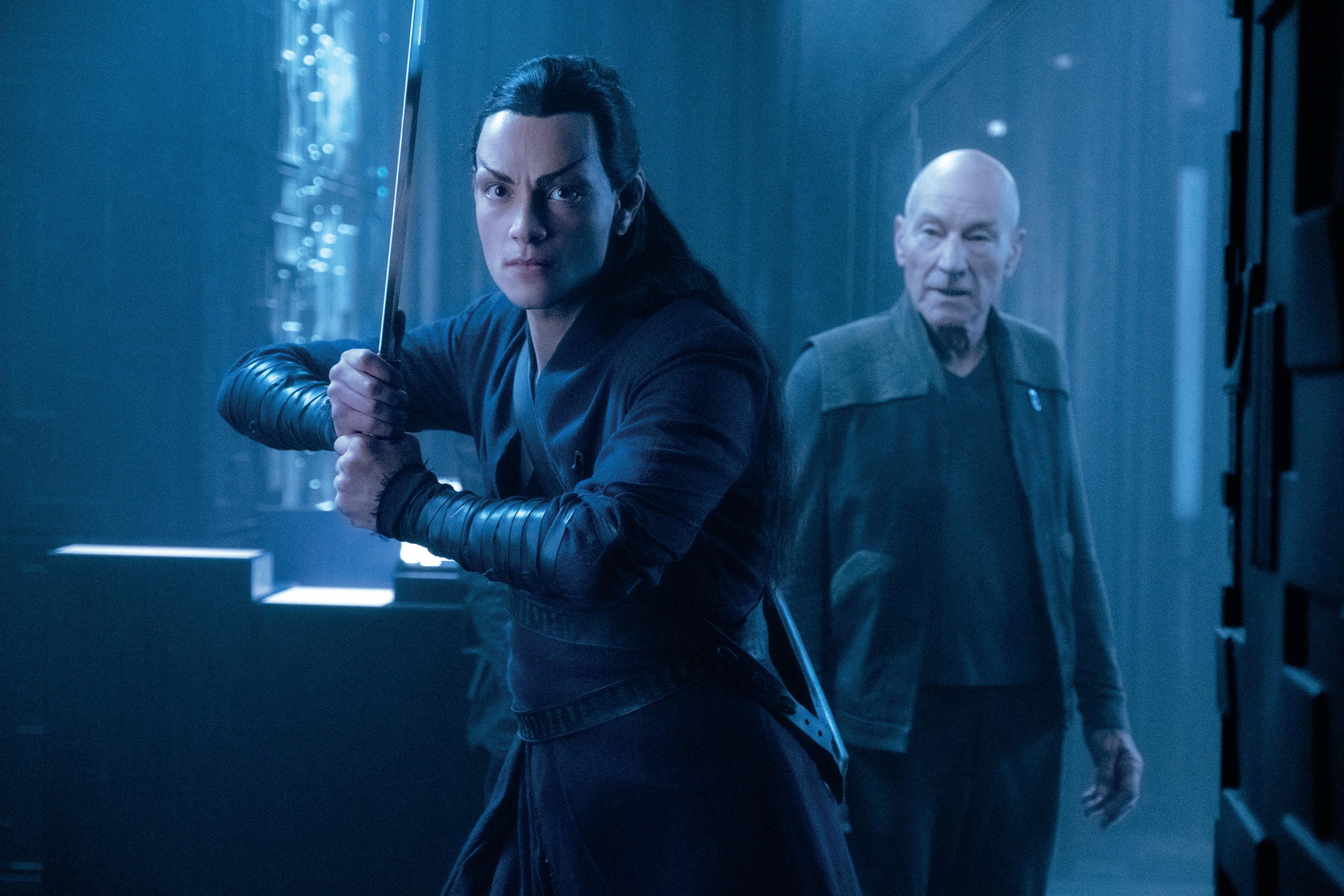
Phasers, transporters and Starfleet were not a new frontier for Lanyon. “Glen Keenan csc had me hired on Star Trek: Discovery for one episode, and I was able to shoot and see how they were practically lighting the ship. I worked with [executive producer] Alex Kurtzman and [co-executive producer/director] Douglas Aarniokoski, who asked me if I would consider shooting the new Picard show in Toronto. Partway through planning, the show moved to Santa Clarita, California, and I immediately flew down to meet with crew and suppliers to get a sense of the resources available.” A co-creator, along with Kurtzman, Kirsten Beyer and Akiva Goldsman, was novelist and screenwriter Michael Chabon. Working with Kurtzman, who had a strong vision for the show, Lanyon developed a look book that included visual approaches, references, camera movement guides, colour themes, and how much lens flare to use. “I wanted to create a consistency between different directors and DPs. Our first director, Hanelle Culpepa small handheld rig with a motion senper, wanted to bring in a lot of warmth to sor on it that a camera operator could the château and create this sense of ease control and add a handheld movement to and a happy place of retirement, but also a crane move. Pro-Cam provided a slingan uneasiness for a Starfleet Admiral who shot, which is an elbow, that could be put has spent his life in space. Hanelle and I between the MovieBird and Matrix head met with Patrick in advance to see what that could be articulated. We could go his hope was for the show, and he wantfrom low to high to Matrix mode, even ed this to be different from TNG. While during the shot; that was an awesome TNG was top and flat lit, Picard is grittier piece of equipment.” with a more natural approach.” Key crew members were gaffer Ross The camera style reflected the tone of Dunkerley, key grip Walter “Bud” Scott, the story. “The vineyard wanted to feel A camera operator Kenny Brown, more stable, locked and classically moved,” Lanyon states. “As the show progressed into a darker and uneasy territory, we introduced a lot more “Working with Chris is handheld.” A handheld style was adopted for crane shots too. “Our key grip, amazing. He’s an old friend and mentor. As Bud Scott, brought in a soon as I heard that Matrix 4 Axis gimbal that we ended up using all the there was going to be time. We were able to use second unit, I called him.”
Santiago Cabrera (centre) as Rios in Episode #106 "The Impossible Box".
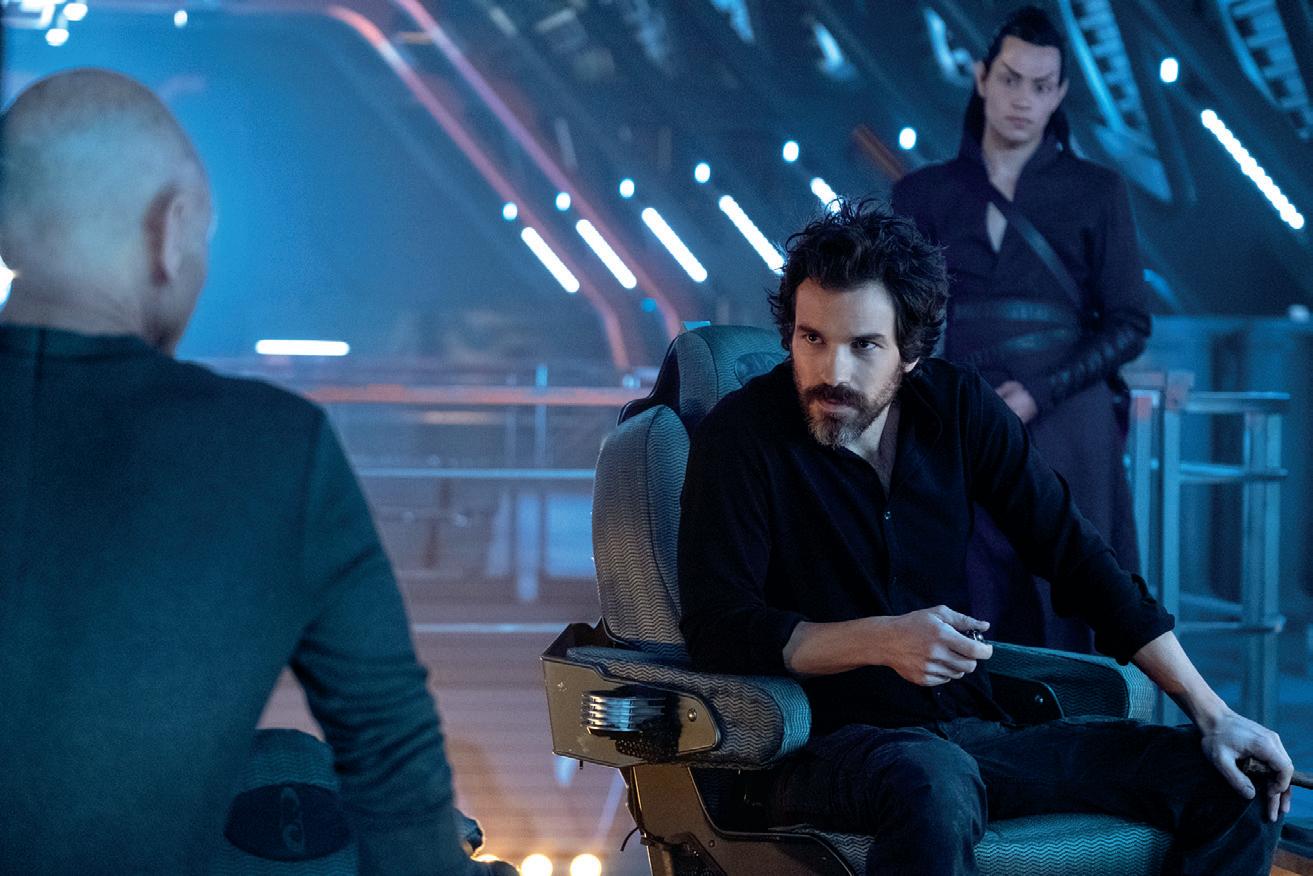
B camera operator Jess Lakoff, 1 st AC A camera Jamie Felz, rigging gaffer Sean Higgins, fixtures design supervisor Mike Visencio, lighting console programmer Josh Thatcher, dolly grip Eric Zucker and rigging key grip Josh Drew. “I prepped for about three months before Darran Tiernan came on, and during the last month of that we were heavily involved in phone conversations; I would send him updated filmscapes and scripts. Darran works frequently in Los Angeles so had some good crew recommendations. I would interview people, including Darran’s recommendations, and we built a team that we knew we could both collaborate with,” Lanyon says. Two major stages contained spaceship sets for the La Sirena and Borg cube. “We had five stages total at Santa Clarita Studios, which had the château interior that became the holodeck, some more Borg worlds, and a swing stage that would become other shortterm sets,” Lanyon explains. “Most of the prep and preplanning was spent building the Borg cube and La Sirena.” Tax credits of $15.6 million were given to the production to shoot in California, with the principal photography taking place mainly in and around Santa Clarita. “We also shot at Vasquez Rocks as they wanted to honour the original series that filmed there.” Ninety percent of the La Sirena was practically lit with help from production designer Todd Cherniawsky. “I put LED strips in the main console to light the faces and added a strip on top that would be the source of the hologram that the visual effects could tie into,” Lanyon remarks. “I decided to use the entire length of the ship as a background for the bridge so we removed a wall to get the depth. I also wanted a massive amount of light coming out of the warp core at the other end so I could backlight and flare the lens all the way up from the cargo bay to the cockpit. My gaffer Ross Dunkerley and I found a Film Gear LED Space Light at the lamp dock that you could see right through because of the cooling fins within them. I had Todd put six of these in a circle and a Creamsource LED Space Light in the centre. In behind that was a fire lane where we pasted silver bounce pebble on the backwall. We blasted a circle of Colour Force into it so you could see through the fins of this colourful display and could change the mood if the ship was in warp, or resting, or impulse power. “On the bigger Borg stage there was a massive open space that had a two-storey set at one end; the upper level had a raised walkway that led to a wall of regeneration chambers,” Lanyon continues. “The entire stage was wrapped in blue screen. The spacecraft is approximately the size and scale of a moon, so
TREKING FORWARD By Trevor Hogg
No matter the scale of a project, what remains important to Christopher Mably csc is the script, and such was the case with Star Trek: Picard. “A Star Trek show is always going to have huge expectations, but Picard was personal for me. I grew up on Next Generation, so being asked to contribute on another chapter of Picard’s story was really rewarding to me. I was shooting second unit so I was tasked with cleaning up and figuring out things as fast as I possibly could. In general, you’re coming in without as much information as the main unit. Sometimes you’re trying to piece together why you’re doing what you’re doing.”
Mably has known Philip Lanyon csc for a long time. “When I first started shooting television commercials, Phil was a fantastic gaffer in Vancouver and we worked together on different projects and have remained friends ever since,” he says.
“Phil is proficient and amazing at his lighting designs because he can see the bigger picture and does it from a story-driven mentality. Phil told me to, ‘Have fun and explore.’ He was a great collaborator and knew the show like he wrote it,” Mably observes. “I never met Darran Tierran isc because his blocks were finished by the time I came in. When I started, Phil had a detailed look book that broke everything down to exactly how to key the faces of actors to the specific colour
(L-R) Sir Patrick Stewart as Jean-Luc Picard; Alison Pill as Agnes Jurati in Episode #110 "Et in Arcadia Ego, Part 2". codes for the Federation and Borg worlds. It was like a written and visual bible as to how to shoot Picard. He also supplied me with an abundance
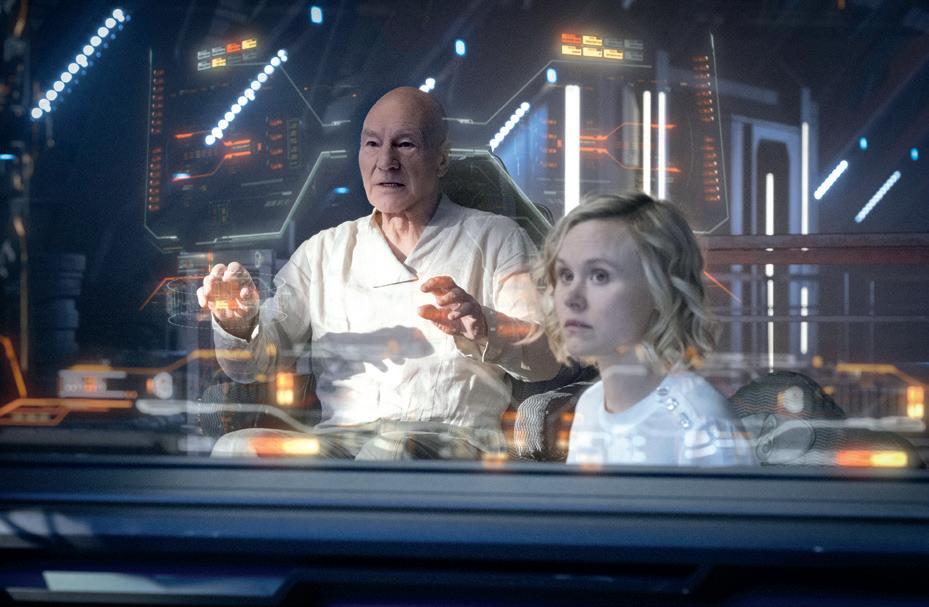
of other graphic art of the sets, but ultimately by the time I started working, main unit had shot enough that I could also reference scenes and episodes of the show.” The captured footage ranged from pick-up shots to entirely new scenes. “There is a Romulan ship, which has a very small part in the show that they hadn’t built any sets for yet. We were looking at concept art, but the set was going to be virtually created. I loved having a creative input into little things like that.”
Enhancement photography focused on the
space battle in the season finale. “The third act of Episode 10 was reworked,” Mably reveals. “Picard is in the La Sirena caught in middle of a large space battle. It’s quite an epic portion of the finale. We had a lot to shoot in the La Sirena with Picard and Dr. Agnes Jurati [Alison Pill]. La Sirena had to encounter a bunch of elements that hadn’t been written into the show before. They took off from a planet where the ship had crashed, got shot and spun around like crazy, and this huge battle happens where things are flying past and illuminating La Sirena in various ways. We had to add some lighting based on the script to augment what was happening outside the ship. There were going to be these giant orchids coming past the ship and you needed to feel them. I wasn’t 100 per cent sure what the visual effects were going to look like as they are built after the cut. The lighting I was putting in to create movement and shape would be based on visual effects elements later, but whatever speed I moved the lights at, the visual effects department was going to have to match.”
As with the first unit, Mably utilized ARRI ALEXA Mini cameras. “I shot with the same Cooke Anamorphic/i SF package as main unit. They are beautiful lenses that have a good front anamorphic feeling to them and are pleasing on skin and faces. The show feels cinematic because of this lens choice. The vast majority of lighting was done with LEDs. We had some Molebeams and large Fresnels that Phil had been using a lot with gaffer Ross Dunkerley to create hard light when needed. For the enhancement shoot, they had a 20K digital extensions were used to create scope. A smaller Borg stage had a long hallway set with different areas that could be changed into different Borg areas. I knew early on that the Borg cube was going to come back alive and regenerate in later episodes. During construction, we built in this activation lighting, which would be triggered by Seven of Nine [ Jeri Ryan], that consisted of long RGB LED strips within the Borg cube structure. Everything goes green with augmentation by visual effects.” The Romulans utilize work lights while mining the Borg technology that were constructed by the art department. “One of the designs was like a floor lamp consisting of twofoot-long LED strips with four hard sources on the ends. I wanted these to serve a few different purposes. I could place them near an actor and give them a key light that was in shot or use them in the background as a flare for the lens or to add a pool of light in the dark set.” Primarily, two to three ARRI ALEXA Mini cameras were utilized with Cooke Anamorphic/i SF lenses. “One of the advantages of the ALEXA image is its ability to hold highlights,” Lanyon notes. “Since I was going to flare the lens so much, I knew that soft highlight roll-off was going to be crucial. The ALEXA Mini is such a great camera in terms of size and adaptability. I wanted to move the camera and get it in interesting places. We also used a Blackmagic Pocket Cinema Camera 4K on rigs and mounts for action sequences to get in close on people; it has a very filmic image that you could cut short shots in with the ALEXA.” Footage was captured ARRIRAW at 3.4K with the aspect ratio being 2.39:1. “We wanted to do anamorphic right from the beginning. Almost every Star Trek movie was shot anamorphic, and we wanted that big event movie feel. The 65 mm Macro was a go-to lens; it seems to be a magic focal length where you can get
(L-R): Rebecca Wisocky as Ramdha; Isa Briones as Soji; Jonathan Del Arco as Hugh; in Episode #103 "The End Is The Beginning".
an extreme close-up shot and see some background. It has the approximate width of a 32 mm spherical. We carried an 8 mm and 10 mm spherical and the anamorphic Cookes 25 mm, 32 mm, 40 mm, 50 mm, 60 mm, 65 mm, 100 mm and 300 mm.” Lanyon has frequently collaborated with Mably. “Working with Chris is amazing. He’s an old friend and mentor,” Lanyon states. “As soon as I heard that there was going to be second unit, I called him. Chris is incredible in planning and had a scene that was a large space battle at the end of the series, which he meticulously broke down into shots and shot lists so we could see what his approach was going to be. Chris and I reviewed the look book and footage already shot. I

T2.5
60mm, 90mm and 150mm MACRO
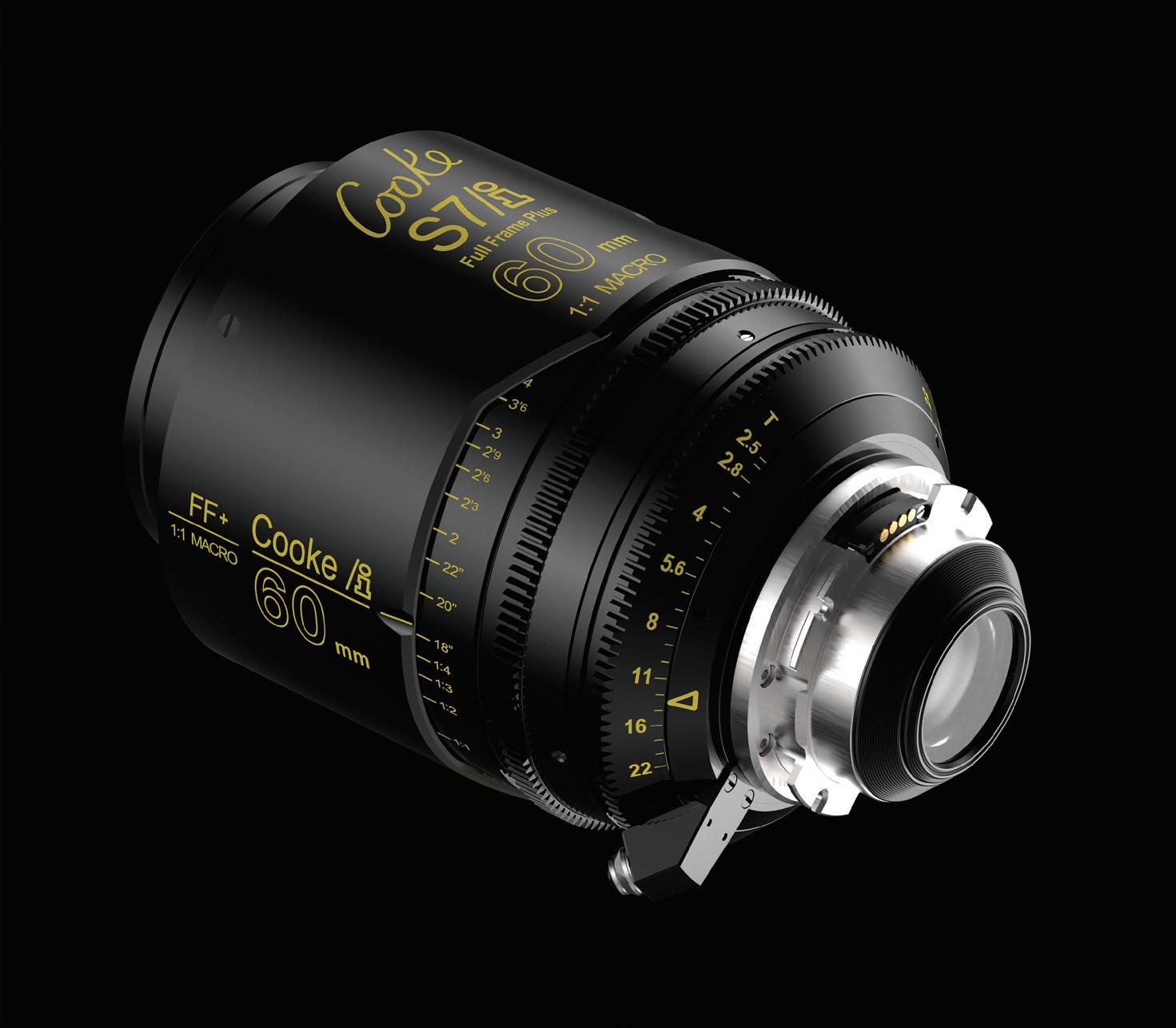
S7I Full Frame Plus
1:1 Macros

NEW
After the positive response to our MACRO lenses in our Anamorphic/i and Anamorphic/i Full Frame Plus series, we are introducing not one… not two… but three new MACRO lenses to the popular S7/i Full Frame Plus range. As always, these are Motion Picture lenses designed from the ground up at our factory in Leicester UK. Cooke S7/i Full Frame Plus Primes cover Super 35mm/Full Frame, VistaVision and cinema camera sensors up to the full sensor area of the RED Weapon 8K and the Arri Alexa 65 5K mode. Available in focal lengths: 16, 18, 21, 25, 27, 32, 40, 50, 60 MACRO, 65, 75, 90 MACRO, 100, 135, 150 MACRO, 180 and 300mm. PL or LPL mounts available.
British Optical Innovation and Quality Since 1894. cookeoptics.com T: +44 (0)116 264 0700 Cooke Americas cookeamericas.com T: +1-973-335-4460
www.cookeoptics.tv
www.shotoncooke.com
globe, which could be used as a sun. I needed a moving sun as La Sirena takes off and flies out to orbit. We put that globe on a 50-foot Technocrane and moved that around. But for the most part, the ship itself was lit with SkyPanels and a variety of other embedded LEDs. It was amazing because no matter where you were on La Sirena, you could quickly change the shape of the light through the dimmer board. La Sirena gets hit by a blaster and
Caption

Chris Mably csc
spun around a whole bunch of times, so we made it feel like the ship had a power failure with lights flickering and then La Siena resets and cycles back on. It was so simple and easy to do because we had full control. Phil had worked tirelessly early on in prep helping to design a lot of this embedded light, and along with looking interesting on camera, a lot of it could be used practically for the actors.”
Getting access to Matrix and Chapman M7 four-axis heads allowed for an infinite range of movement. “Both heads were on a Technocrane and have a Mimic handheld attachment with them so the operator could use a handheld brace and virtually operate the camera in a handheld manner,” Mably remarks. “There was one shot where the camera was flying through space and finds Narek’s [Harry Treadaway] ship, goes through the window, and lands on his close-up. You can point the head straight out from the Technocrane instead of dropping down underneath it or doing a top or low mount; that allows you to get it in small narrow spaces. It’s an incredible tool that the show used consistently, and we were fortunate to steal it for second unit a bunch.”
A favourite moment is the battle scene in Episode 10. “Because of the motivation from the script, we got to move the camera a lot in some fun ways,” Mably recalls. “It’s a pivotal scene for Picard’s character development. It was an eye-opener because I had never worked on a big American network show. What is interesting about doing second unit is a cinematographer doesn’t often work with other cinematographers. With Star Trek: Picard, I got to work with and talk about everything with Phil; that’s unique and was an exceptional experience.”
Credit: Marc Pierce let him run with it, and he matched the look perfectly while adding his own special fl avour.” Supervising the visual eff ects was Jason Zimmerman who is also responsible for Star Trek: Discovery. “Some shots would be previs; for the most part, I would check in with Jason during prep and he would let me know what was possible,” Lanyon says. “Jason really gave us the freedom to move the camera and think big. We had a bluescreen that wrapped almost 360 degrees of the Borg set. We used Cineo HS2s which have a blue spike in them, and they could be played at a low level and get an even light. It wouldn’t aff ect the talent or what you were doing onset.” A complicated scene to execute was when Raffi Musiker [Michelle Hurd] questions Captain Cristóbal Rios [Santiago Cabrera] and four holographic versions of him in Picard’s study in the holographic winery. “Director Maja Vrvilo and I strategically planned the two-day shoot and knew the exact number of shots needed. We had four stand-ins, so each would be able to double for Santiago and know his lines. Santiago would rehearse each part and switch with the doubles. We wanted some camera movement to sell the eff ect. We used a TechnoDolly to create repeatable moves, as well as a repeatable Libra head and two other cameras that were not locked off that could get singles aft er the master. We would shoot a master on the TechnoDolly and a couple of singles of one character. Santiago would go through makeup and wardrobe for the next character. Jason Zimmerman patched it all together, and the end result was seamless.” Most of the colour palett e was captured in camera. “We shied away from any high fl uorescent colours like purples or electric blues and went for a subdued palett e,” Lanyon says. “Stefan Sonnenfeld, who owns and runs Company 3, would have every face pre-windowed. Th e DI process was so streamlined and slick with him. I wanted to add some grain into the highlights so it didn’t feel like a noisy underexposed image in the shadows. Stefan showed me a bunch of options and we worked out a base LUT beforehand. Using the base LUT, the DIT Marc Clancy and I built looks on top of it for every set.” Lanyon is a Star Trek fan, so gett ing to help tell the story of Star Trek: Picard was incredibly exciting. “Th e writing and producing teams were so supportive and collaborative with the cinematography; they really let me have fun and explore ideas,” he says.
Caption: (L-R): Sir Patrick Stewart as Jean-Luc Picard; Amirah Vann as Zani in Episode #104 "Absolute Candor".
